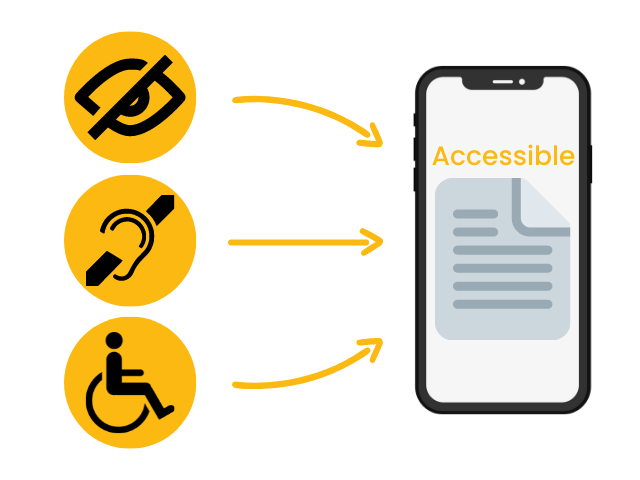At Square, inclusion is part of our values: this includes digital accessibility.
What is digital accessibility?
Digital accessibility is the publication of information by means of a digital document or medium. This information can be text, images, pictograms, and anything else that can be found on the various media.
PDF and Digital Accessibility
The PDF (Portable Document Format) was created in 1992 to facilitate the publication and exchange of documents in complete security.
It is a document standard managed by the ISO (International Organization for Standardization).
Thanks to the PDF format, it is possible share the same document to all users, which is an inclusion factor.
By default, PDF documents are not accessible to some users with disabilities:
- People who suffer from blindness or very low vision who use screen readers. For their optimal reading, the PDF must be structured or marked up.
- Visually impaired people, who are sensitive to the choice of colours and font size.
This is called “redistribution”, users can change the colours and/or change the information display to make it easier to read at high zoom. - Dyslexic people will benefit from tagging if they use a speech reader, or from redistribution which improves the display.
- People with physical disabilities who navigate exclusively by keyboard can do so more easily thanks to markup.
Accessibility is a fundamental right worldwide
As such, it represents a legal obligation for all actors.
– Accessibility is also a founding principle of the online web.
Tim Berners-Lee, the inventor of the World Wide Web, stated that “the web is fundamentally designed to work for all people, regardless of their hardware, software, language, culture, location, or physical or mental ability.
Accessibility: a social matter issue for citizens
Digital accessibility primarily concerns people with a varying degree of hearing, cognitive, neurological, physical, speech and visual disabilities.
In 2010, the WHO counted approximately 15% of the world’s population as having a disability.
In 2011, INSEE estimated that 9.6 million people in France were affected by a disability.
If we consider ageing and hearing or visual disabilities, then everyone is affected one day or the other by digital accessibility.
It is predicted that approximately 120 million people in the EU will have multiple and/or minor disabilities.
Accessibility is a factor of social inclusion in a broad sense.
It also benefits people without disabilities, for example
- Elderly people whose abilities change with age
- People using mobile phones, connected watches, connected TVs, and other devices with small screens, different input modes, etc.
- People with a “temporary disability” such as a broken arm or lost glasses
- People with a “situational limitation” such as being in direct sunlight or in an environment where they cannot listen to audio
- People with slow Internet connections or limited or expensive bandwidth
Accessibility: a basis for digital responsibility
- Socially: accessible digital technology promotes social inclusion for all citizens in the age of digital transformation.
- Environmentally, digital accessibility methods facilitate the transition to an eco-responsible Internet. Indeed, accessible websites are often more sober and less energy consuming.
This is even more important as a report by The Shift Project measures that “the digital sector’s share of greenhouse gas emissions has increased by half since 2013, from 2.5% to 3.7% of total global emissions”, this means more than civil aviation.
In this sense, the authors of the White Paper “Digital and the Environment“ (in French) propose to “make the eco-design of public or private websites and online services mandatory for companies with a total turnover of more than 250 million euros.”
Google is blind, deaf and has no hands
Google doesn’t click on links; addresses items in navigation order and doesn’t understand much of what you write.
In fact, Google believes that “accessible search is an essential and natural evolution of our mission to improve the organization of information and make it universally accessible.”
All recommendations for good SEO are often valid for website accessibility too.
In June 2006, the web giant launched a new version of its engine with focus on accessibility.
As a result, accessible sites and PDFs are likely to get increasingly better rankings on the search engines.
Finally:
For the W3C (World Wide Web Consortium), every individual who wishes to use the Web should have access to content which is:
- Perceptible – information and components must be presented in a way that users can perceive them, they may not be invisible to all their senses
- Usable – the components must be usable. The interface may not require interaction that a user cannot perform
- Understandable – the information and use of the interface must be clear; the content or use cannot go beyond anyone’s understanding
- Robust – the content must be robust enough to be reliably interpreted by users and assistive technologies. The user must be able to access the content as technology evolves (content must remain accessible)
What we do at Square!
At Square, we have proven experience in accessibility in the broadest sense.
The best practice is to integrate the notion of accessibility as early as possible in the creation of any document.
In fact, we can integrate the notion of accessibility into a native InDesign file for better efficiency and to ensure the future re-use of the document. This is particularly true for updates, because any work done on a PDF is not re-usable.
Accessibility concerns:
- The addition of alternative texts for images and pictograms
- The neutralisation of artefacts (= graphic elements which are not text) which do not add anything to the reading experience and may blur comprehension when read by the voice assistant.
- Tagging the document to ensure navigation in the document by going from titles to subtitles and thus bypassing the constraint of a tedious linear reading. This different and more complex than simply creating an interactive table of contents.
- The reading order must also be reworked because the voice assistant will follow by default the order in which the document was created. So, if the title was added at the bottom of the page, it risks being read last.
- The redistributed reading order is a second level of document preparation that will concern those who cannot see very well: the visually impaired. Texts will be larger and the reading order is reworked to be more linear.
- The colour contrast is also very important. We check and modify colours using standardised tools to guarantee optimal legibility for all visually impaired people.
We have done a lot of work for different organisations:
- For the Guide Dog Association in Central East France
– Accessible digital content in their “Guide Dog” magazine
– Accessible mobile application, available on the App Store and Play Store - Accessibility of derogatory travel certificates (more than 50 documents) for the Ministry of the Interior during the Covid crisis (produced in unfavourable conditions and on very short notice).
- Internal communication documents for the French Employment Centre (Pôle Emploi).
- Accessibility audit for the DOMPLUS MACIF site performed by our experts.
- FALC (Easy To Read and Understand) product manuals for the SEB company (household appliances)
- Proof of Concept of a product website which is accessible via a QR code on L’Oréal printed packaging, which helped l’Oréal to win the global accessibility prize.
We also offer training courses:
- For the general public (awareness and understanding)
- For graphic designers who create documents (production techniques)
Beyond our technical expertise and the practice of our profession, we are convinced that accessibility is essential for inclusion. Ethics and CSR are driving us, and we are proud to contribute through our accessibility, evangelisation, and training activities.

